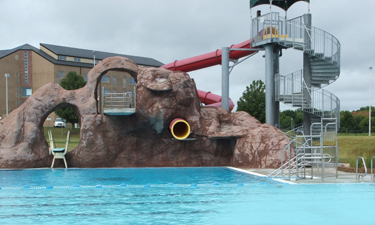 When examining the amenities prevalent in today’s public aquatic facilities, it doesn’t take long to figure out that waterparks are influencing agency innovations. But as industry experts attest, it’s not “becoming a waterpark” that is driving agencies. It’s thinking like one.
When examining the amenities prevalent in today’s public aquatic facilities, it doesn’t take long to figure out that waterparks are influencing agency innovations. But as industry experts attest, it’s not “becoming a waterpark” that is driving agencies. It’s thinking like one.
“Cities don’t want [the waterpark] characterization because they don’t want to have to charge high fees,” says Dave Schwartz, owner of Kansas-based Water’s Edge Aquatic Design. “They want to make it reasonable to visit a facility, while providing features for everybody in the community.”
“Today’s agency must-haves are predicated on the creation of an experience,” says Tom Poulos, principal and vice president of Williams Architects in Illinois. “This means amenities that will extend visits to a facility and encourage more frequent use.”
Making Waves and Repeat Audiences
Bruce Verink, recreation division manager for Cedar Falls, Iowa, cites the lazy river as the defining feature of his city’s $7.1-million aquatic facility. “On an 85- or 90-degree day, our lazy river will probably have 200 people on it at any given time,” Verink says, noting that close to 800,000 people have used the facility for open recreational swimming alone since its launch in 2005.
According to Poulos, lazy rivers are topping agency want-lists due to their multi-generational appeal. “If you have the land, they can be a great family attraction,” he affirms. He adds that in addition to tube riding, lazy rivers can serve as venues for resistance swimming, exercise classes, and special events.
The FlowRider is a relatively new feature for facilities that’s “making waves”—particularly with the tough teen market. “They aren’t cheap, but from a standpoint as an operator, it was absolutely worth it,” says Susan Beaurain, division manager for Monon Community Center, Carmel Clay Parks and Recreation, Indiana. The popular simulated surfing feature rushes water at 30 miles per hour and 30,000 gallons per minute.
Beaurain says the FlowRider was fundamental in engaging new teenagers, many of whom came to their aquatic facility specifically to use the amenity. In an award-winning adaptive program, individuals with disabilities learn to use the amenity during designated times—at their own pace and with assistance.
Play Time!
Spraygrounds continue to increase in popularity for toddlers to tweens. Schwartz points out that many attributes, including timed features, dumping buckets, and slides, can be customized to fit agency budgets.
Additionally, Schwartz notes the popularity of inflatables. While water depth, pool size, and the age of users will determine appropriateness, the amenities are effective for engaging youth. “You can create obstacle courses…miniature versions of those crazy, wonderful things you see on TV,” Schwartz adds.
Renewing Tried and True
Lap pools have always been popular, and according to Poulos, the key is to optimize use with designs that can accommodate competition, fitness, and recreation. “You want to meet the minimum requirements of a competitive regulating body like USA Swimming, but with shallow water that can be used for other things, such as instructional swimming and water aerobics,” Poulos states.
Water slides remain in high demand, though agencies are going “taller, longer, and scarier,”—in the form of raft riders, multi-person rides, dramatic slides, and slides with run-outs. Schwartz emphasizes swirling bowl slides, which spin users around before dropping them into a pool basin. “They’re pricey, ranging $300,000 on average,” acknowledges Schwartz, “but kids will stand in line for 20 minutes to use them.”
The expenses associated with deep water, and liability concerns, have decreased the presence of diving boards at facilities—but not necessarily their popularity. In lieu of a three-meter springboard, Verink says Cedar Falls installed a three-meter platform, which reduced the depth of the water well required, and cost. And it’s been a hit. “Typical lines form of up to 25 to 30 people,” he adds.
Experience +
Poulos emphasizes the enduring significance of zero-depth entry water for enhancing leisure and social engagement. “It’s the one element that emulates the beach experience,” he states. “There’s a comfort level…people can acclimate before they go to another water depth. Additionally, if properly sloped, zero-edge water provides ADA access.”
And for outdoor facilities, experts espouse the importance of shade. “Shade has gone to new levels, from being on decks in the turf areas…all the way to the water,” Poulos states. “Being in the water, but still being under shade, is a must-have from many of our clients’ perspectives.”
Amy Kappis a freelance writer in Northern Virginia.

